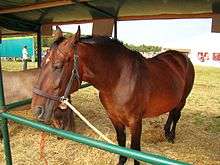Silesian horse
 A Silesian horse in Rudawka Rymanowska | |
| Alternative names |
Koń śląski Ślůnski kůń Ślaski |
|---|---|
| Country of origin | Poland, historic Silesia |
| Breed standards | |
| Polski Związek Hodowców Koni | Breed standards |
| Equus ferus caballus | |
The Silesian horse, Polish: Koń śląski, Silesian: Ślůnski kůń, is a breed of warmblood horse from the area of historic Silesia, which lies mostly within modern Poland. It is the heaviest of the Polish warmblood breeds, and has been influenced mainly by the Thoroughbred and Oldenburg, and partly by the East Friesian and German halfbred. The Oldenburg influence was particularly pronounced after World War II, when imported stallions were used to keep the breed from becoming extinct.[1][2] Two types are recognised in the breed standard, an old and a new. At 3 years old, stallions of the old type stand 160–170 centimetres (15.3–16.3 hands) at the withers, mares about 2 cm less; the girth is 190–210 cm (75–83 in), and the cannon-bone circumference about 23–24 cm.[2] The new or racing type is taller and lighter, stallions standing 164–170 cm (16.1–16.3 hands) at the withers and mares about 2 cm less; the girth measures 185–200 cm and the cannon-bone 21.5–23 cm.[2] Stallions average 650 kg (1,430 lb), mares 600 kg. The current stud-book dates from 1961; registers for this type of horse have been kept since the late 19th century. In 2008 the breed numbered about 5000.[1]
References
- 1 2 Domestic Animal Diversity Information System Food and Agriculture Organization of the United Nations. "Ślaski (Poland)". Accessed September 2011.
- 1 2 3 Program hodowli koni rasy śląskiej Warsaw: Polski Związek Hodowców Koni 2007 (in Polish) Accessed September 2011.
.jpg)